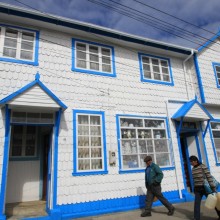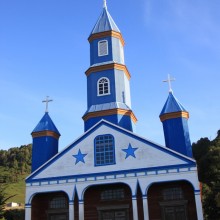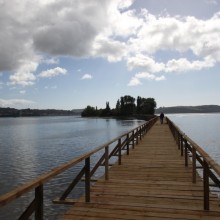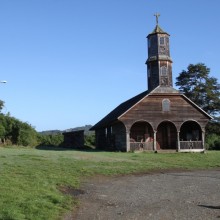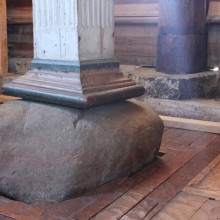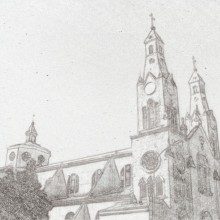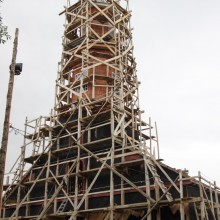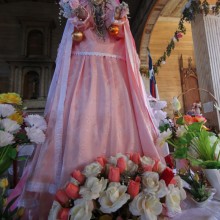Program
Day 1
This tour begins with a look at the beautiful wooden church of San Francisco in the center of Ancud and a visit of the exhibition about the UNESCO protected churches. The ‘Amigos de las iglesias de Chiloé’ or ‘Friends of the Chiloé churches’ house the headquarters of the UNESCO World Heritage churches around the island. A one hour drive drive on the last stretch of the Pan-American Highway takes you to Castro.
We visit some often overlooked places in and around Castro like the local fish, fruit and vegetable market, the ‘Ten Ten lookout’, the stilt houses or ‘palafitos’ and the never finished copper museum of Castro in Guggenheim style.
After lunch in a local restaurant we drive to the tiny village of Nercón with its UNESCO wooden church. On the way to Nercón we stop and have a look at the stilt houses of Gamboa. These stilt houses or ‘palafitos’ in Spanish were built in the beginning of the 20th century by fishermen. With the earthquake and tsunami of 1960 most of the stilt houses on the island were destroyed but luckily not so in Castro.
From here it is a half an hour drive to Dalcahue where we take the ferry to the island of Quinchao. Arriving on Quinchao is like returning 50 years in time. Everything here happens at an even slower pace than on the main island. In Achao we visit the oldest church of Chiloé. This church stood model for most of the other wooden churches built in the late 18th, 19th and early 20th century. Further south in the village of Quinchao we’ll visit the recently rebuilt church.
In San Juan, back on the main island, we have a look at one of the last shipyards where two families still build wooden boats. The church of San Juan is also worth a visit for its setting right next to the sea and its simple but decorative architecture. The village of Tenaun is our final destination for today but before we arrive we’ll stop at the waterfalls of Tocoihue. Set in a dense forest these waterfalls are unique on the island.
Tenaun has one of the prettiest churches of the island in one of the most beautiful settings overlooking the ocean. On a clear day you can even see the Andes mountain range. A local family of farmers and fishermen will be your host for the night in their cozy Bed & Breakfast. Mireya Montaña, the owner of the B&B, cooks splendid meals for her guests with local specialities.
Day 2
After a tasty breakfast we continue our route along the coast and visit the charming villages of Colo and Quicaví with their respective small churches. Quicaví is the village where the witches of Chiloé come together in caves and perform their malignant witchcraft. With their ghost ship ‘El Caleuche’ they travel the seas in search of victims while little creatures, ‘los Invunche’, guard their caves. On the beach people sometimes see ‘la Pincoya’, a lady dressed in seaweed and kelp who predicts good fortune for those going out fishing. When she is angry she turns her back to the sea and all fish and shellfish disappear.
The famous writer Francisco Coloane (Tierra del Fuego, The Whale’s path, Gulf of Sorrow, etc.) was born close to the fishing village of Quemchi that we will visit in the late morning. We’ll also walk to the island of Aucar over a 500 meter (547 yard) long wooden bridge. Coloane named the island ‘Island of the sailing souls’ as there is a small cemetery and church. Children from a local school helped planting the educative botanical garden on the island.
Barloventos is an excellent sea-side restaurant where we’ll have lunch and for those interested we can visit the museum of Francisco Coloane. The museum was floated to its actual place from a few kilometers away and a video in the museum shows how this tradition of house moving (by land and sea!) is still in use.
In the afternoon we visit the city of Ancud. In the indigenous language Ancud means ‘belly shaped hills’ and we’ll drive up one of those hills to enjoy the 360º view of the bay, the harbor, the coastal mountain range and on clear days the Andes mountain range.
Ancud was vital in the war of independence (1810-1826) for the defense of Chiloé against the Chilean army. The people from Chiloé wanted to stay under Spanish rule and so it took 16 years before Chiloé was annexed to the sovereign state of Chile. There are remains of a Spanish fortress overlooking the Bay of Ancud that we will visit.
Other places of interest that we can visit are the fish, vegetable and handicraft market, the harbor, the historical center with its shingled houses and the museum.
Folkloric festivals in summer
Every year during the summer months (January and February) all over Chiloé there are festivals with local food, music, dance, country skills and animal shows. These local festivals give you an excellent insight into the island’s culture and gastronomy. Whenever there is the possibility we will visit these festivals if the client is interested in doing so. In general the folkloric festivals are on Saturday and Sundays.
What is included in the price: Transport, bilingual guide, food, drinks and accomodation

